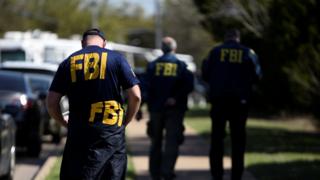 Image copyright
Image copyright
Reuters
An FBI spokeswoman said the agency suspected a link to previous bombings in the state
US authorities are investigating whether a parcel bomb that exploded at a FedEx depot in Texas on Tuesday is connected to a suspected serial bomber.
The incident occurred at 00:30 (05:30 GMT) in Schertz, 65 miles (104km) south of the city of Austin, where four bombs have killed two people in recent weeks.
One person was lightly injured but did not require treatment, police said.
Police also sent a team to a FedEx facility near Austin airport to investigate a suspicious package.
FBI spokeswoman Michelle Lee told CNN the agency believed the blast in Schertz could be connected to the previous attacks.
Local media, citing law enforcement sources, report that the bomb which went off in Schertz was addressed to Austin.
What else do we know of the FedEx explosion?
The bomb which exploded in Schertz was filled with nails and shrapnel, officials say.
A female employee standing nearby was treated at the scene for a possible concussion, the website adds. About 75 employees were working in the depot at the time.
Hours after the blast, police said a hazardous materials team had been sent to a FedEx shipping facility near Austin’s airport to check reports of a suspicious package.
How did the earlier attacks unfold?
If the explosion in Schertz is linked to the previous four, it will be the first time the bomber has used the mail.
Image copyright
FBI
Three of the four devices were hidden in parcels left at residential addresses in Austin while police say the fourth was probably activated by a tripwire:
- The first device exploded on 2 March, killing Anthony Stephan House, 29, at his home
- Hours later on 13 March, a 75-year-old Hispanic woman, who has not been named, was injured by another package
- On 18 March, a device injured two men who may have set off a tripwire while walking along a street in the south-west of the city
What lines of inquiry are police following?
Investigators initially said they were looking at a possible racial motivation for the attacks, which had killed two black men and injured a Hispanic woman.
However, the two men injured in the 18 March blast were both white.
“With this tripwire, this changes things,” said Christopher Combs, the special agent in charge of the FBI’s San Antonio office.
“It’s more sophisticated. It’s not targeted to individuals. We’re very concerned that with tripwires, a child could be walking down the sidewalk and hit something.”
Fred Milanowski, the special agent in charge of the Bureau of Alcohol, Tobacco, Firearms and Explosives in Houston, said the agency had a “high degree of confidence that the same individual built all these devices”.
Fred Burton, chief security officer for Stratfor, a private intelligence and security consulting firm based in Austin, was quoted by Reuters news agency as saying the individual or people behind the bombings were likely to be highly skilled and methodical.
“This is a race against time to find him before he bombs again,” Mr Burton said.
What action is being taken?
Mr Combs said more than 350 FBI special agents had been drafted in to work on the investigation, calling it an “unprecedented response.”
The FBI made a rare public appeal to the bomber to get in touch. “We would really like the bomber to contact us so we can talk to him,” Mr Combs said.
Austin police have offered a $100,000 (£71,340) reward for information, and Texas Governor Greg Abbott has offered an additional $15,000.
Residents in Austin, a city of 974,000, have been asked to look out for suspicious packages.
Texas explosions: FBI investigates new blast at FedEx plant

